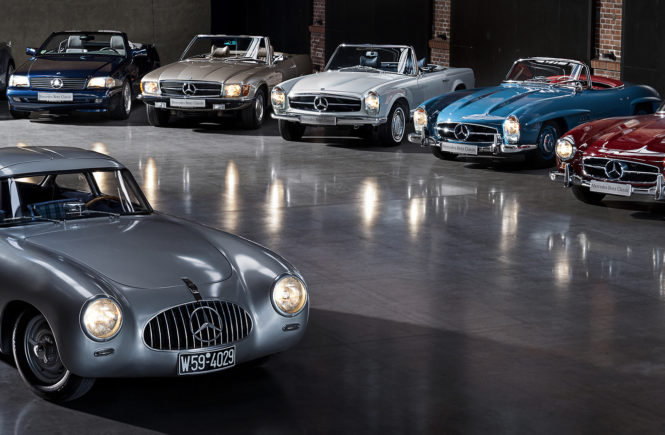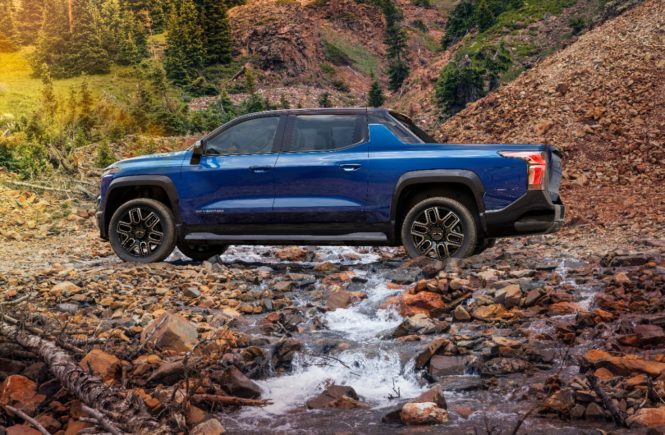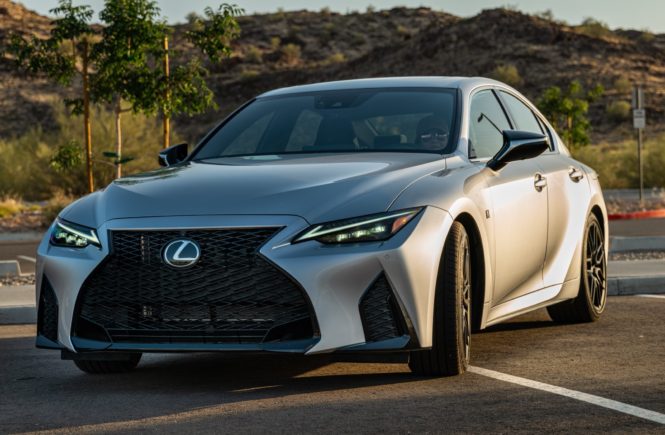
An industry expert’s idea: A compact and agile Mercedes-Benz sports car – ideal for the North American market. This was something Max E. Hoffman emphatically advocated for as the brand’s importer for the eastern United States. He even travelled to Stuttgart-Untertürkheim to sell the idea. The Austrian-born New Yorker was convinced of the importance of such a vehicle for the US. The minutes of a meeting of the Board of Management on the topic dated September 2, 1953 noted: “Mr Hoffman is confident […] that big business cannot be expected in the US without enhancing the range by models that are more than suitable for the local market. […] In the US it is expected from Mercedes-Benz – as a company with a particularly good reputation – that, whatever happens, they develop a sports car that can evolve to become the sole basis for the dealership organization’s survival.”
The birth of SL sports cars: The project quickly took shape. On September 7 and October 3, 1953, Karl Wilfert, then Head of Mercedes-Benz Vehicle Testing and later Director of Body Development, reported the current status. It centered on the “compact sports car” (what would go on to become the 190 SL), and also around the 300 SL for export to the Americas. This exclusive series-production sports car was developed on the basis of the successful 1952 300 SL racing car (W 194) and the injection engine of the racing car prototype for the 1953 season. Walter Häcker, Head of Mercedes- Benz Body Design, was tasked with “designing the body shape and appearance” of the 190 SL. The Sindelfingen plant was awarded the task of designing the vehicle and model type of the 300 SL.
Preparing the US premiere: The debut of the two sports cars had been scheduled for the 1954 International Motor Sports Show in New York. Associated preparations were on the agenda of the Board of Management meeting of Daimler-Benz AG on September 14, 1953. CEO Dr Fritz Könecke, Head of Development Dr. Fritz Nallinger and the Member of the Board of Management responsible for export, Arnold Wychodil, decided that “a 180 model sports car will be launched in due time; the two 300 SL demonstration vehicles will be handed over to Mr Hoffman in February or March 1954.” Over the following weeks the 180 became the 190 SL, as Mercedes-Benz was keeping the abbreviation “SL” as a result of the associated racing success. In 1952, the press information about the racing car already explained that the “S” stood for “super” and the “L” for “light”.

Flamboyant debut in New York: The 300 SL Coupe (W 198) and the open-top 190 SL (W 121) were at the center of attention of the International Motor Sports Show in New York between February 7- 14, 1954. What Mercedes-Benz had achieved up to this point was Herculean: only six months after Max E. Hoffman’s visit to Untertürkheim the 300 SL “Gullwing” was attracting plenty of attention. The vehicle had almost reached series-production maturity, mere details of the production version were subsequently modified. The 190 SL showcased in New York in 1954 was still a prototype. It differed from the subsequent series-production version by elements including the bonnet that stretched down to the radiator grille featuring a small air scoop, deviating radiator grille proportions and smoothly shaped rear wings without the characteristic fins. Walter Häcker was to revise these design details until the start of series production in 1955. The public and press were thrilled by the premiere: both vehicles, neither of which had been available in Mercedes-Benz’s portfolio up to this point, hit the nail on the head in North America.
Questions about the future: Max E. Hoffman was aware of how thrilled customers in the US were about open-top sports cars. For this reason, he reiterated to Arnold Wychodil that he also wanted a roadster version of the Mercedes-Benz 300 SL, even while the International Motor Show was still ongoing. As early as February 20, 1954, Mercedes-Benz commissioned a corresponding sample vehicle for a 300 SL Roadster featuring a steel-sheet outer skin. The roadster celebrated its premiere in March 1957. The sports car with conventional doors replaced the 300 SL Coupe with its characteristic gullwing doors in the model range.
Mainstays of passenger car model range: Export figures reflected how popular the Mercedes-Benz SL was in North America. In 1954 and 1955 alone, 85 percent of the 300 SL Coupe models (850 of 996 vehicles) produced over this two-year period were exported to the United States of America. All in all, by 1963 Mercedes-Benz had delivered more than half of all 300 SLs (Coupe and Roadster) to North America. In its first production year – 1955 – around 40 percent, or 830 units, of all US exports by the Stuttgart-based brand were 190 SLs. Nearly half of all 190 SLs were destined for the United States in 1955. The proportion of this sports car’s annual production exported to the US was even higher in 1957 at 54 percent. In total Mercedes-Benz sold 10,368 of 25,881 190 SLs ever produced in North America – amounting to 40 percent, and making the US the most important individual market for the compact sports car. Here Mercedes-Benz SL vehicles proved to be a mainstay for the brand’s entire passenger car range.

US Sports Car Champion: The Mercedes-Benz 300 SL also underlined its sporty heritage by claiming motorsport victories in the United States. US American racing driver Paul O’Shea won the category D US Sports Car Championship three times in a row. He was victorious both in the 1955 and 1956 seasons in a 300 SL Coupe. In 1957 he claimed the championship at the wheel of a 300 SLS – a special variant of the 300 SL Roadster that was built only twice. Compared with the series- production sports car, the 300 SLS was characterized by elements including its lighter weight – which had been reduced to 2,138 lbs – and an engine output that had been boosted by 20 hp, now totalling 235 hp. Externally, it was immediately distinguishable by the absence of bumpers, a specially shaped cockpit cover with air inlet slit, a narrow racing windscreen and a roll-over bar behind the driver’s seat.
“California” Roadster: In 1963 the “Pagoda” W 113 model series SLs succeeded both predecessor models. A very special variant of the sports car celebrated its premiere in February 1967 with the introduction of the 250 SL. The “California” Roadster did away with the roadster soft top and soft top compartment, thus granting space for some rear seats. This variant of the sports car offered unadulterated driving pleasure in regions with very little precipitation as it did not have a soft top and merely offered the add-on coupe roof. This “Pagoda” SL version was extremely popular in the United States. Whenever these vehicles were exported to Europe from the US, “California” Roadsters regularly caused quite some astonishment. Retrofitting a soft top to this body variant is only possible with complex and costly conversions.
Engine variants for North America: In the early 1970s the R 107 model series Mercedes- Benz SL was initially available in the US as the 350 SL 4.5. Just like the 350 SLC 4.5 Coupe, this was a version featuring the low-compression version of the 4.5-liter V8 M 117 engine which had been adapted to US exhaust emissions standards. As a result of more stringent emissions legislation in California, no less than two versions of this vehicle were delivered from 1974: vehicles supplied for California generated around five percent less output. As of model year 1975 Californian values then applied to all US export vehicles.
Striking outline: All R 107 model series 380 SLs, introduced in 1980, which were exported to America were equipped with modified bumpers to comply with US American crash regulations. They protruded significantly further at the front and rear than those fitted to vehicles for other markets. In total the SL became 9.8 in longer as a result.
Almost an independent USA model: As of model year 1985, Mercedes-Benz offered the R 107 model series 560 SL as the variant with the largest displacement. The engine was devised by extending the stroke of the 500 SL unit. The 560 SL with a catalytic emissions control system as standard generated 230 hp, and thus 15 hp less than the 500 SL without a catalytic converter. The sports car with the 5.6-liter V8 engine was almost exclusively sold in the United States of America (93.75 percent), with further markets being Australia and Japan.
Special US models: The technologically innovative R 129 model series Mercedes-Benz SL was available in several special model variants for customers in North America. For instance, the particularly exclusive Mercedes-Benz SL 500 “US 500 Edition”. A mere 40 vehicles of this model were produced on the occasion of the “U.S. 500” race on May 26, 1996 at Michigan International Speedway as part of the Champ Car World Series (CART). Further R 129 special models for North America included the “40th Anniversary Roadster Edition” (1997), the “Formula One Edition” (2000) and the “Silver Arrow Edition” (2001).
Strictly speaking: In 2006, when Mercedes-Benz introduced the facelifted R 230 model series SL generation, the SL 500 had been equipped with the new 5.5-liter V8 M 273 engine (388 hp) instead of the 5.0-liter V8 engine. This also brought about a modified model designation for customers in North America, given that US legislation at the time specified that model designations derived from the vehicle’s displacement had to reflect the actual value. For this reason, the vehicle was available in the US as the SL 550.




